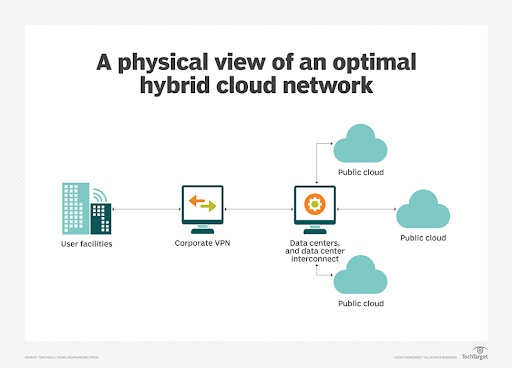The Hybrid Cloud Report 2021 by NTT claims that “93.9% of the c-suite executives consider technology as an imperative part of their businesses. The wave of COVID-19 has escalated the dependency of organizations on technology. A total of 89.6% of organizations are reliant on technology since the pandemic has struck the world. Presently, 60.9% of organizations colossally either use Hybrid Cloud or are planning to introduce the same technology in the upcoming years.”
A Hybrid Cloud Infrastructure is a computing model. Being an IT architecture, Hybrid Cloud Infrastructure offers both automation and elasticity. Business owners are always advocated to stay ahead of the curve in terms of technology. Known to have an upper hand in providing cost-effective solutions, Hybrid Cloud Infrastructure, in this sense is a way to go.
“Hybrid Cloud has come up as a tactical foundation to achieve substantial agility, which is becoming an imperative element for the organizations.”
But, what exactly is a Hybrid Cloud Model? How would it benefit your business? This article is meant to walk you through every detail of Hybrid Cloud Infrastructure from scratch. Let’s dive right into it.
What Is A Hybrid Cloud Infrastructure?

As the name suggests, Hybrid Cloud is a platform that integrates more than one Cloud Service like Public and Private Cloud in a single environment enabled by some form of orchestration among both the services. Sometimes Hybrid Cloud also includes on-premises infrastructure.
To understand it better, having an insight into the aforementioned cloud services is important. Below are a few details related to it:
 Public Cloud
Public Cloud
- Public Cloud is simply an IT model where computing services are managed by a third-party provider.
- The services provided by a Public Cloud are shared with multiple businesses using the public internet.
- Public Cloud gives access to everyone irrespective of their identity and it is comparatively cheap.
- An example of a Public Cloud is Microsoft Azure.
 Private Cloud
Private Cloud
- A private cloud is a computing model in which the infrastructure is committed to a single user organization.
- It is far more expensive than a Public Cloud Service.
- Not everyone has access to Private Cloud because it acts as a reserved table at a restaurant.
- An example of a Private Cloud is Oracle.
In simpler terms, Hybrid Cloud is an IT design that consists of both Private and Public Cloud and at times on-premises infrastructure. The hybrid Cloud, as a computing model, provides application maneuverability among both public and private clouds.

The flexibility of the business grows widely when the data is moved to a Hybrid Cloud Infrastructure. Most organizations find it a notable shift to a Hybrid Cloud as it proves to be a cost-optimal cloud service.
As per your business demands, Hybrid Cloud Infrastructure migrates workloads across the environments. The operation of Cloud services is quite complex, deciding on a Public or Private Cloud solely does not solve the issue.
So, Hybrid Cloud Infrastructure should contain some elements listed below:
- A Hybrid Cloud Infrastructure should be able to connect various devices such as computers through a network
- It should unite all the IT resources, be it software-based or hardware-based, well
- Be freely able to move day-to-day tasks among all the environments
- The hybrid Cloud should incorporate a sole management tool
- The automation feature provided by Hybrid Cloud Infrastructure should be able to orchestrate processes
The businesses adopting Hybrid Cloud Infrastructure can comfortably store delicate data on a private cloud simultaneously enjoying the benefits of a public cloud.
The effectiveness of a Hybrid Cloud is at its best when the service is well-architected. This brings us to our next point, What is a Hybrid Cloud Architecture? Let’s have a look!
What Is Hybrid Cloud Architecture And How Does It Work?
Hybrid Cloud Architecture is just a blend of public and private cloud services. This fusion unlocks modern tools that enable orchestration among applications. The functioning strategy of Hybrid Cloud Infrastructure seems possible because of:
- Data Virtualization
- Connective Tools & Protocols: Local Area Network (LAN), Wide Area Network (WAN), Virtual Private Network (VPN), and Application Programming Interfaces (APIs)
- Connectivity to several Cloud Providers

The interconnectivity among the services should serve the following purposes to achieve great workability:
- Smooth migration of workloads among services
- The management should be unified
- The processes should be orchestrated
The above implementations help in achieving a successful Hybrid Cloud Infrastructure. Organizations can migrate workload across all the services and so business owners tend to incline towards a Hybrid Cloud Infrastructure which further has two variations.
Types Of Hybrid Cloud: Traditional vs. Modern
There are two types of Hybrid Cloud Infrastructures: Traditional Hybrid Cloud and Modern Hybrid Cloud. Traditional Hybrid Cloud involves both private and public clouds. These cloud services are linked by LAN, WAN, or VPN. Enterprises adopting the Traditional Hybrid Cloud either can create their private cloud or can get it done through pre-packaged clouds.

Unlike traditional cloud services, Modern Hybrid Cloud can function without networks as it uses a common operating system for the deployment of all applications. Modern cloud uses software-defined networking technology with network virtualization.

There are a variety of Hybrid Cloud Platforms that offer an efficient operating model which smoothens the business.
What Are The Different Hybrid Cloud Platforms?
Organizations can come across high demands at any point in their business. They can scale and pay for the same, however, the suitability of the Cloud Platform may face issues.
Hybrid Cloud Platforms are focused on certain management tools which ensure the synchronized working of both services. Companies based on their IT requirements, choose a suitable cloud platform.
Below are examples of some popular Hybrid Cloud Platforms:
 Customer Managed
Customer Managed
Customer Managed Cloud in a way acts as a Private Cloud which can be put to use in on-premises infrastructure. It can even be deployed in hyper-converged infrastructure. Portions of this Cloud Service are even offered as Software-as-a-Service.
 Vendor Managed
Vendor Managed
Hybrid Solutions become highly manageable as a Vendor Managed Cloud Platform. It is a fully hosted software as well as hardware-based Cloud Solution.
 Partner Managed
Partner Managed
A lot of Cloud Service providers offer Hybrid Cloud Infrastructure as a solution. Known to offer a consistent infrastructure, Partner Managed Cloud Solution smoothens the business operation as well.
 Cloud Provider Managed
Cloud Provider Managed
Quality Cloud Services are provided by large-scale Cloud Providers. The solutions provided are based on the foundational infrastructure. The business operations become highly compatible with the Private Cloud.
The installment of Hybrid Cloud Infrastructure requires a lot of investment and care, however, the efforts are all worth it. The Cloud Service provides some major benefits to uplift the business performance.
Understanding The Benefits Of A Hybrid Cloud Infrastructure

Over the past decade, Hybrid Cloud has increased its dependency on companies. There are many reasons why organizations choose to stick to a Hybrid Cloud among so many options because the hybrid cloud is:
 Less Costly
Less Costly
Business owners should always be prudent about the cost they spend or the investments they make. Organizations shifting from their previous cloud to the hybrid cloud must know that cost becomes the primary key. Adopting Hybrid Cloud Infrastructure is the most cost-effective way as it provides companies with better security at a very reasonable cost.
Organizations using Hybrid Cloud do not need to spend huge capital expenditures whenever the demand spikes. They are supposed to pay only for the Cloud Services they are using.
 Enhances Scalability And Control
Enhances Scalability And Control
Business is an evolving field. The IT services you are using today might fluctuate tomorrow, or worse, can even discontinue at any point in time. With Hybrid Cloud Infrastructure, organizations can easily scale their tasks according to the changes. With enhanced scalability, Hybrid Cloud offers better control over company data.
It is not only known for providing enhanced scalability but also for better automation making it easier for companies to adjust their cloud settings and achieve maximized business performance.
 Better Maneuverability
Better Maneuverability
We know how markets are speedy with their products and other trends. When companies fail at coping with the expeditious trends of the market, it destroys their respective hierarchy to a great extent. The hybrid cloud model provides companies with the required maneuverability which helps in meeting all the business demands.
The process of data transfer becomes simplified with the hybrid cloud and it enables the use of edge computing making the IT framework as fast as possible.
 Security
Security
Companies using the Hybrid Cloud model have the benefit to manage it according to their IT needs. The Private Cloud, on one hand, can be used for safeguarding the data, Public Cloud on the other hand is used to squeeze out all the powerful options it offers.
The hybrid Cloud makes it way easier for companies to store, transfer and protect data. It reduces the data exposure which in return helps companies in having enhanced control over their data.
 Business Constancy
Business Constancy
With Hybrid Cloud Infrastructure, the constancy of the business is stabilized with no possible technical interludes. When the services go down due to any server issue, companies have to spend a lot of money in recovering them. The hybrid Cloud Model in this sense proves to be a smart solution. This continuity happens to prevent the servers from getting overburdened which is the major cause of servers going down.
 Interoperability
Interoperability
A hybrid Cloud involves more than a single cloud platform. This feature simplifies the interoperability among workloads as components of one platform can be seamlessly transferred to another. An effortless business functioning can be promised with Hybrid Cloud as a solution.
Hybrid Cloud being a new wanted in the world of IT, evidently has proven to be a boon for most organizations. However, the implementation of a Hybrid Cloud faces some common and uncommon challenges which may act as stumbling blocks when put to use.
What Are The Challenges Faced By A Hybrid Cloud Infrastructure?
Below is a close examination of some major challenges faced by businesses when they shift to a Hybrid Cloud Infrastructure:
1. Difficulty In Relocating Workload
Migrating your workload from one Cloud Service to another can be a damning event. Not only does it take time but it is also resource-intensive. Moving the data to a Hybrid Cloud needs to integrate:
- Sole Cloud Providers
- Endemic Characteristics
- Multiple Elements
Most organizations lack the necessary IT skills, which are required to deploy the work from the previous Cloud to Hybrid Cloud. Before migrating, several tasks should be performed by the team such as:
- Scrutinizing workload characteristics such as Operational and Performance
- There should be a capacity plan which will help in eliminating underutilized services
- The planning for data security, network, storage should be done beforehand
- The present applications should be made serviceable across an on-premises infrastructure
2. Issues In Governance
Governance plays a vital role in IT setups. Traditionally, it was used to provide insights but presently there are some set goals of governance, which are to:
- Promote Evenness
- Provide correct direction and insights
- Betterment of the IT setup
- Accelerate the processes
Organizations should approach the service provider with three motives: a) to shoot up automation, b) self-management and c) software-expounded unified management infrastructure.
They can even adopt the Cloud Management Platform (CMP), which is known to simplify the working strategy of Private and Public Cloud as a united platform.
3. Data Security
The adoption of a complex Hybrid Cloud can endanger data no matter if the data is at rest or is working. However, the types of threats to data differ depending on whether the data is active or is in transit.
Various interludes and alterations can pose a threat to the data. There are some ways through which organizations can achieve data protection, such as:
- Adopting Full-Disk Encryption can be a primary source of data protection, a process used to encode data through an encrypted key.
- The Trusted Platform Module (TPM) should be a part of Network Bound Disk-Encryption (NBDE). This helps in the addition of extra security layers.
- The users must not enter their passwords into encrypted drives manually as this poses a threat to their security.
- Moving to Hardware Encryption can also protect the data at a high level because the encryptions take place within the drive.
4. Concern For Compliance
Majorly, the organizations dealing in large sectors target Hybrid Cloud Infrastructure. There are certain regulations required to govern the data that belongs to the customers. This data is very delicate and so falls prey to threats, at times. The security in that sense should be at its best as the storage of the customer data remains a concern.
Migrating the workload to Hybrid Cloud is beneficial choice business owners make. However, it makes maintaining compliance in the business difficult.
To ensure compliance in your business, make a note of the following things:
- If your organization follows a concrete regulation, you should include it in the initial workload planning.
- When working on a Hybrid Cloud, make sure to inspect each division, individually. The inspection should be done both as a single service as well as a unified service.
- Every organization has its own set of rules and regulations. Hybrid Cloud Infrastructure should be compliant with them all.
5. Outlay
Migrating your workload from the previous Cloud to Hybrid Cloud surely helps in reducing the overall cost, however, the cost can exceed your budget if not planned strategically. But, the adoption of a Hybrid Cloud Infrastructure can also help in picking out all the oddities in both services.
This detection helps in preventing all sorts of service shortages hence preventing massive expenses.
6. Unclear Range Of Supervision
The adoption of a Hybrid Cloud requires a broader and clear range of visibility and control over business operations. But, organizations find themselves struggling with this. This ambiguity leads to the following consequences:
- Organizations may face issues in instantaneous developments.
- The unclarity in the vision causes an absence of collaborations.
- The implementation of self-service systems becomes difficult which creates a ruckus in the long run.
- The configuration settings may lose their lucidity to the lowest.
A characteristically superior cloud model Hybrid Cloud is often confused with a term almost synonymous with it i.e Multi-Cloud model. Among the terminological similarities, there is, in fact, a difference in both terms.
Hybrid Cloud Model vs. Multi-Cloud Model
The fact that these terms Hybrid Cloud and Multi-Cloud are often used interchangeably has increased the misconception of them being homogenous. Both the models integrate more than one cloud platform, however, the infrastructure brings the key difference between them.
A Hybrid Cloud Infrastructure is a combination of both Private and Public clouds with some form of orchestration among them. It provides companies with great flexibility by making workload migration easy. Conventionally, the private clouds were inbuilt, known as on-premises. But, currently, they are built off-premises.
A Multi-Cloud Model, on the other hand, contains only Public Cloud Infrastructure such as infrastructure as a service (IaaS), platform as a service (PaaS), etc. Whenever businesses outsource application hosting to a third-party such as Google, Amazon, or Microsoft then it is considered a Public Cloud.

Besides the basic difference between both the terms, Hybrid Cloud and Multi-Cloud are known to bring efficiency to businesses. The Hybrid Cloud efficiently manages the existing networks and Multi-Cloud focuses mainly on delivering IT resources as a service.
Is Hybrid Cloud Secure?

YES! The Hybrid Cloud is a highly secured platform when it comes to protecting an organization’s data.
All organizations are deeply concerned about their sensitive data which is no less than a valuable asset in a business. While migrating your workload to a Hybrid Cloud, it is common for you to question the authenticity of the platform. However, Hybrid Cloud acts as a secure base for all types of businesses, hence eliminating every doubt of being a weak platform.
A Hybrid Model should be properly set up and integrated among itself. This way, Hybrid Cloud can achieve the same level of security as that of conventional on-premises infrastructures. This model, in terms of security, proves to be the best out of all as it represents an integrated platform.
Factors To Prioritize When Choosing A Hybrid Model
Organizations shift to a hybrid model to simplify their business functioning. Before adopting this enchanting contract between different cloud services, there are some factors an organization should go through.
Familiarize Yourself With Your Workloads
Understanding and analyzing your company’s workload is an important aspect that helps decide on a suitable Hybrid Cloud Model. The business demands are situational, and it grows wide as you expand your business.
Organizations should focus on a hybrid model that can adapt well to the changing business needs. With workloads, you need to decide on where to locate the model. Understanding your workload helps you choose a model that integrates well with various platforms and devices.
Homogenous Infrastructures
Most organizations use an on-premises infrastructure for a smooth business operation. Adopting a Hybrid Cloud that identifies with all the options of your previous infrastructure is required. If your private and public clouds align properly, it helps simplify your workload migration.
Uncomplicated Onboarding
Migrating your workload from one infrastructure to another can be a damning event. It is time-consuming and can be a little troublesome with large-scale data. You should always opt for a model that has an easy onboarding process so that workload migration does not look like a task.
Safety And Certainty
Security plays a crucial role in every business as the company data can easily fall prey to data breaches and hackers. A Hybrid Cloud should be able to protect the data from every internal and external threat.
Hybrid Cloud Infrastructure is known to offer several security measures that act as a shield against threats. Your Hybrid Model should be able to implement various security measures with complete details about compliance and the risk management process.
Assuring Availableness
Data availability is an imperative factor when it comes to a Hybrid Model. Organizations should always make sure to confirm the availability guaranteed by their service providers.
A good Hybrid Provider will not just provide these security measures like tokens, but will also offer compensation if the Cloud Service fails to meet the needs. The provider’s approach regarding security and other measures should be clear, this makes him a trustable fount.
Reasonable Cost
Being mindful of a business budget is the wisest thing, irrespective of the category a business is operating in. To start and end a contract with a service provider is not free of cost. Business owners should go for a model having reasonable pricing inclusive of all the features.
Migrating your workload is not an easy task, so business owners are advised to choose the Hybrid Model wisely after going through necessary considerations. This carefulness will not only help in providing you with the best Hybrid Solution but will also help in building up your business to a great extent.
Isn’t it good to have a guided path to your destination? Unlike those vague founts, we will provide you with a clear picture of some top solutions for a Hybrid Cloud Infrastructure you should go for in 2022.
What Are The Top 5 Hybrid Cloud Solutions For 2022?
As the blog states, in the beginning, most companies will shift their business to different technology in the upcoming years. But, how to decide on which solution is worth adopting or shifting to? Here is a list of the top 5 Hybrid Cloud Solutions for 2022 that businesses must look forward to.
AWS Hybrid Cloud Solution
AWS Hybrid Cloud Solution guarantees to provide you with a consistent AWS experience, be it on-premises or cloud. Being a giant Hybrid Model, it overlaps every service provider as it owns 33% of the entire cloud business.
The cloud services of AWS are known to eliminate the complexity of all the APIs. Businesses no longer need to rely on third-party services, and also adopting AWS frees them from the worries of sudden updates and upgrades.
Hybrid Cloud services like AWS Outpost, AWS Wavelength, AWS Local Zones, and AWS Snow are provided by AWS Hybrid Cloud.
According to the AWS website, it has the following benefits:
- Accelerate digital transformation
- Improves IT and developer productivity
- Deliver differentiated services and experiences

Azure Cloud Solutions
Azure Cloud Solutions are a great fit for the upcoming fresh cloud technologies. The specialty of Azure Cloud is that it can be used anywhere be it on-premises, or on the cloud. Azure Cloud provides various solutions such as Azure Stack Hub, Azure Databricks, Azure Synapse, Azure AI and Machine Learning, Azure SQL, Azure Security, and Azure Cognitive Services.
It does not only enhance the smooth functioning but also implements disaster recovery. Azure, as a cloud service provider, is known as the best leader in the market of private and public clouds. Using Azure Cloud Services brings you many benefits such as application modernization.

IBM Cloud Solutions
If business owners want to shift their workload to any Hybrid Model, it is strongly advised to consider IBM Hybrid Cloud Solutions. Currently, IBM owns only 5% of the entire cloud market, but it still stands as one of the most famous cloud service providers.
There are various cloud solutions provided by IBM such as IBM Cloud Pak, IBM Watson, and so on. The most famous service IBM Cloud Pak is composed of the IBM Red Hat Platform, which makes it possible for the Pak to run on any Hybrid Cloud. IBM Cloud solutions support simplified usage of packed environments as IBM happens to be the first cloud platform to integrate with OpenShift 4, which is an open-driven platform delivering full-stack automation.

HPE Hybrid Cloud Solutions
HPE Hybrid Cloud Solutions are considered to be good cloud solutions for businesses dealing in every forte. HPE follows a hybrid approach so it can provide you with the perfect hybrid environment. It offers a reasonable planned cloud solution as it controls the costs quite rightly.
HPE Hybrid Cloud makes an extensive plan which offers great Hybrid Cloud solutions. Public and private clouds are managed by a single dashboard, which makes its functioning hindrance free. HPE is known to provide the best cloud solutions as some of the top cloud leaders come up with suitable solutions. One of the examples of HPE Hybrid Cloud solutions is HPE GreenLake.

Rackspace Cloud Solutions
Rackspace, which is initiated by RackConnect, has a major focus on infrastructures. Rackspace essentially is used to merge the public and private cloud of an organization. It is a good solution as it provides organizations with the utmost data security and VPN bursting.
Rackspace is a Hybrid Cloud Provider that collaborates with other cloud providers to ensure the best cloud solution. It focuses on additional security by adding firewalls.

When Should You Introduce Your Business With Hybrid Cloud Infrastructure?
Today, almost every organization is working on some, or the other cloud platform. At times, the organizations do not perform well in their business, but it is not because they are incompetent. The sole reason can be an exhaustive cloud service. Knowing when to shift to a Hybrid Cloud is important. But, how to know when is the right time to make a shift from your previous cloud to a Hybrid Cloud? Well, some factors help you decide the right time to migrate your entire business to Hybrid Cloud Infrastructures, which are listed below:
If Your Business’s Expenditure Goes Too High
Cost in any business is the foundation of new and existing projects. If the cost does not suit the organization, the project automatically goes in vain. If we talk from an efficiency point of view, spending tons of amount on just getting the data settled is not very smart a decision.
If you think that your costs are coming out to be extraordinarily high, then this might be an indication for you to consider shifting to Hybrid Cloud Infrastructures. A hybrid Cloud is a blend of public and private cloud that enables the organizations to pay only for the service they are using, instead of spending huge expenditures.
If Your Business Has An Increased Latency
Organizations face latency because their cloud does not support agility. Due to service unavailabilities, wide-scale disruptions take place making business less operable. Businesses dealing on a distributed geographical level might find latency a frequently occurring issue. Achieving substantial agility is very important for every business, no matter if the business makes great deals or has just begun.
Introducing your business with a Hybrid Cloud Infrastructure eliminates the possibility of latency or service shortages as it provides two services of different types. If your business is running back on services, we suggest you migrate your workload to a Hybrid Platform.
If Your Business Is Surrounded By Too Many Identified And Unidentified Threats
Data security is the topmost priority of every business owner. A company’s data is more like its asset, which can’t be put at risk by trusting a random cloud service. Cybercrimes always happen unannounced, and you should never give cybercrimes a way out in the first place.
Adoption of a Hybrid Model helps in reducing the risk of cyberattacks as it safeguards the company’s data with all the necessary security measures. Cyber threats are a little hard to detect, your company might be in threat all the time and you may not even realize it. So, it is always better to stay cautious.
If Your Business Starts Losing Its Key Skills
When you have a forte in something, you never want to lose it because of technological issues. Losing your key skills affect the business to a great extent because you hold its monopoly. Indeed, a business cannot always stay as productive as it stays on certain lucky days, but that should never make your organization lose hold of its key skills.
As a business owner, if you think your business is losing its key skills because of working on an exhaustive and partly supportive cloud platform, we advocate you migrate your work to a Hybrid Model. The hybrid Model will make sure to ease the functioning by introducing features like active cloud architecture, performance reporting, efficient workload management, etc.
Final Word
So, concludingly a Hybrid Cloud Infrastructure tailors the cloud services according to the business demands and comes up with the best cloud solution. Doing so becomes easy as Hybrid Model integrates both public and private cloud platforms simultaneously simplifying the orchestration among the processes and providing the organizations with the benefits of both private and public clouds. It’s a good deal, isn’t it?
Hybrid Cloud Infrastructure proves to be a trustable fount and organizations can easily rely on it. Organizations dream of expanding their businesses to a great extent, with this they want themselves to be completely functional even in the long run. Adopting Hybrid Cloud will help achieve this goal with a simplified working environment, and ensure a budget-friendly business operation.












